German Bread (Authentic Vollkornbrot)
This post may contain affiliate links. See my disclosure policy.
A thoroughly authentic German Bread Recipe (Vollkornbrot)! This delicious traditional German whole grain seed bread is nutrient dense with a fabulous texture and positively packed with flavor. This makes a large loaf that freezes well so you can conveniently grab some whenever you’re in the mood.
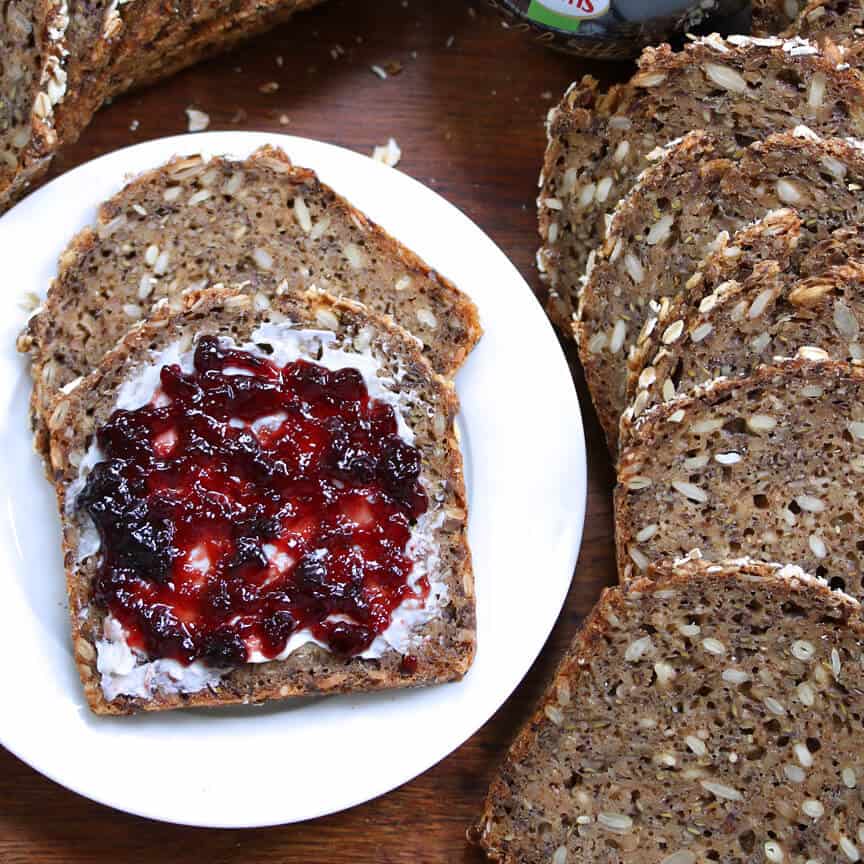
Authentic German Bread (Vollkornbrot)
Few things are better than a freshly baked loaf of bread slathered down with butter and some good jam. That’s true for crusty breads with fluffy interiors and the more hearty, dense breads that I also know and love from Europe. Here is a German bread that is beloved throughout Germany and is also widely enjoyed in Austria and Switzerland. It features a grain called Einkorn that is used throughout much of western Europe, but feel free to substitute other grains according to your preference.
Dense, chewy, packed with nutrition and full of flavor, this whole grain German brown bread (Vollkornbrot) is wonderful with your choice of butter, jam, Nutella, cheese, or cold cuts.
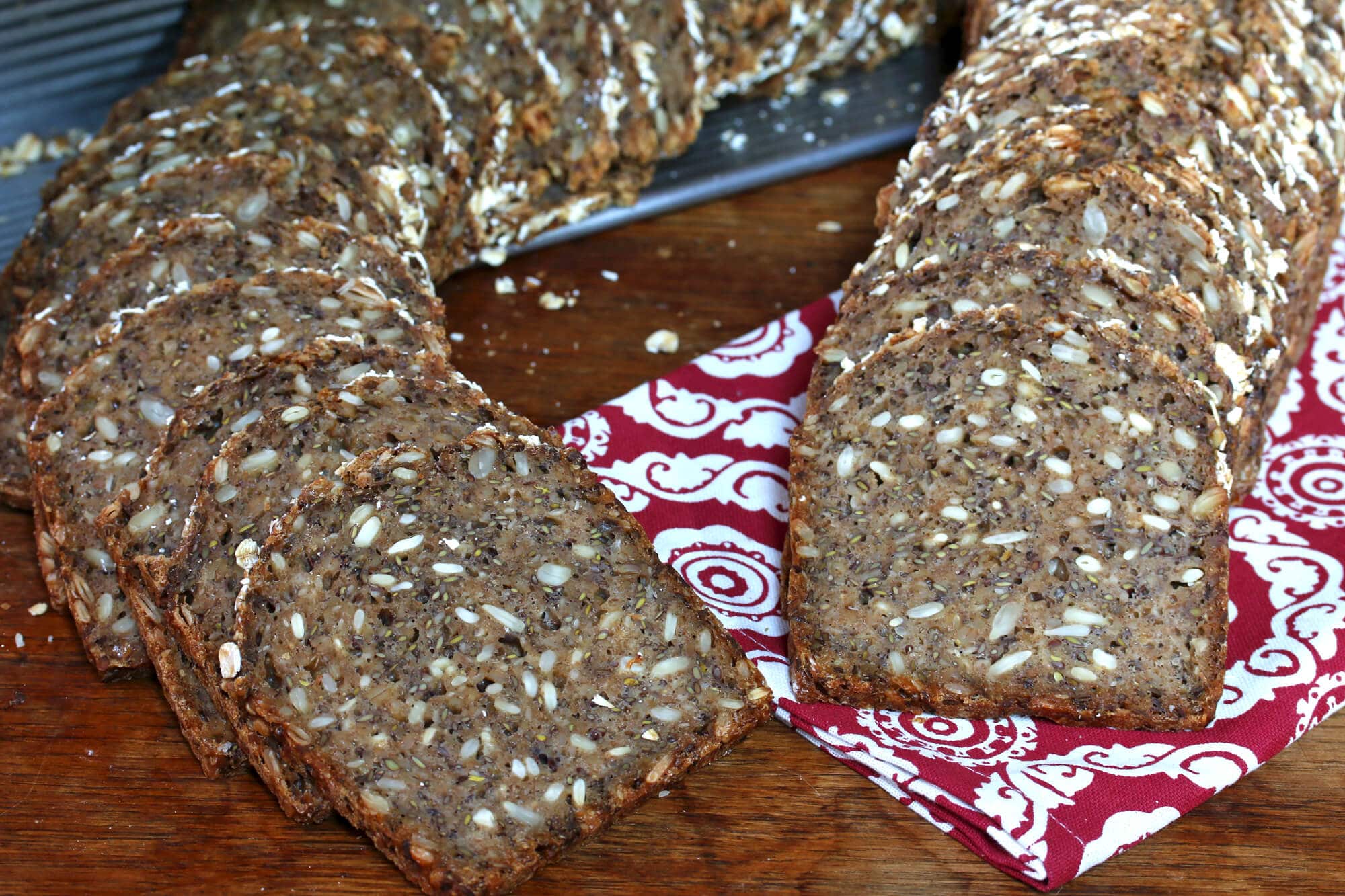
Have you heard of the grain einkorn before? Modern day wheat over the centuries has undergone a series of genetic changes for the purpose of increasing yield and gluten content. It’s almost unidentifiable compared to its ancestor (and my guess is that is why gluten issues are a more recent occurrence). Einkorn is the most ancient form of wheat on earth and hasn’t undergone these genetic changes. It is the purest form of wheat we have. You can purchase einkorn online HERE.
The advantages of einkorn: Most agree it tastes better than wheat and is much easier to digest, even easier than spelt. Compared to the gluten in modern day wheat, it contains a structurally different composition of gluten that the body is able to digest more easily. In fact, some people with gluten issues who have switched to einkorn have found that they’re able to tolerate and digest it with ease.
Even visually there’s a difference between wheat and einkorn. Though there are size variations within different types of wheat, generally most wheat (left) is longer in length than einkorn (right). Einkorn also has a deeper caramel color.
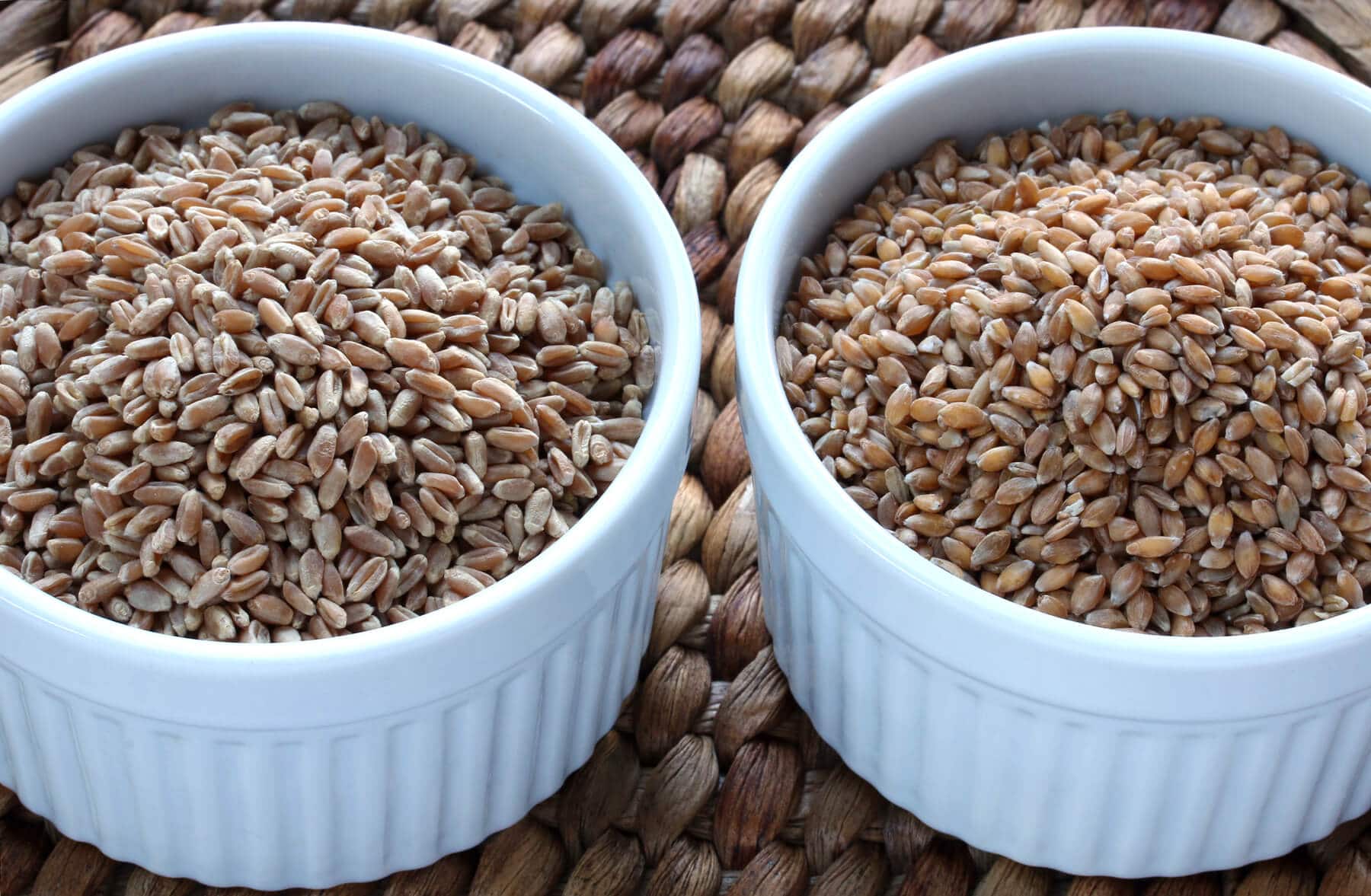
It’s unfortunate that as wonderful as Einkorn is, and common as Einkorn is in many places throughout western Europe, it’s almost unheard of here and very few places sell it. And for that reason it’s also much more expensive here in the U.S.. Hopefully that will change as it becomes more common. The same was true of spelt for a long time and though it’s still far less common than wheat here in the U.S. its price-point has gone down.
I buy all of my grains, including einkorn, in bulk. I take out what I need for a few weeks at a time and store the rest in a dark, cool place. It saves money that way and I have easy access to everything I need. And I LOVE being able to grind my own grains fresh as needed and make up my own fresh baking mixes!
My German-made KoMo grain mill is the pride and joy of my kitchen. German engineering at it’s best, the KoMo grain mill is simply awesome. You can grind your grains as fine or as coarsely as you like. With a 12-year warranty this thing is a work-horse and does a magnificent job. I use it nearly every day grinding my own flours, making cornmeal and a variety of mixes. I cannot recommend it highly enough.
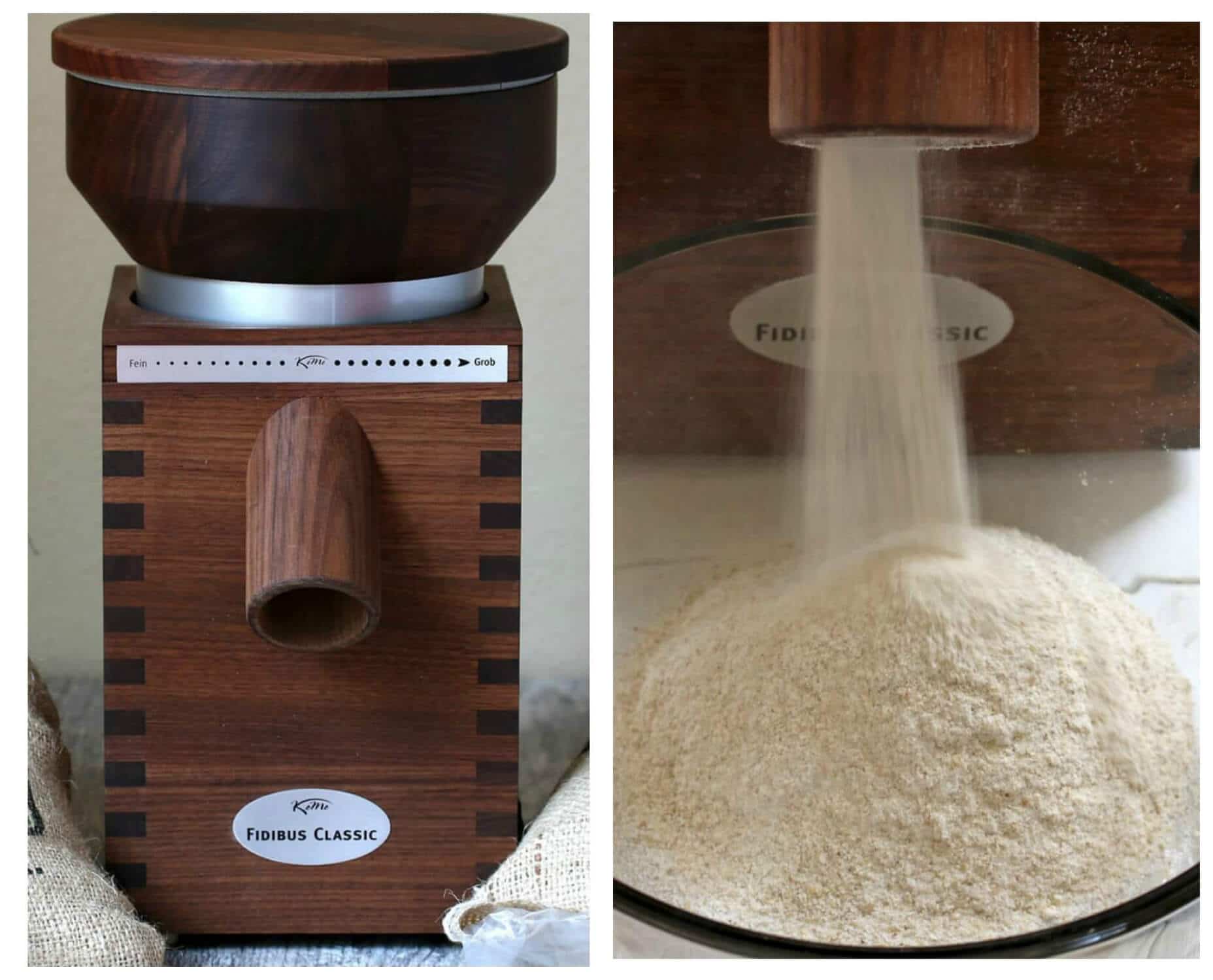
This traditional German bread uses a combination of whole einkorn berries and ground einkorn flour. Whether you’re grinding your own grains or buying the flour already ground, you’re absolutely going to love the texture and flavor of this wonderfully hearty, rustic and thoroughly authentic German bread!
German Sourdough Bread
A couple of our readers have reported back about using sourdough starter instead of yeast. To make this a sourdough Vollkornbrot omit the yeast, add 200 grams of active sourdough starter, and reduce the flour by 100 grams and the water by 100 grams. Give the batter a full 24 hour ferment.
German Bread Recipe (Vollkornbrot)
Let’s get started!
Dissolve the yeast and sugar in the lukewarm water and let sit for 5-10 minutes until frothy. (See above if you prefer to use sourdough starter.)
Place all of the dry ingredients in the bowl of a stand mixer. (You can do this by hand if you prefer.)
NOTE: I personally don’t pre-soak the whole or cracked grain berries and let my batter ferment for a full 24 hours which softens the berries. Depending on the age of the grains you’re using they may require a pre-soaking in order to be adequately soft. If you wish you can pre-soak the grains overnight (pour hot water over them and let them sit) and then thoroughly drain for an hour or so.

Add the yeast mixture along with the buttermilk and beer. Knead on the bread setting (#2) for 10 minutes.
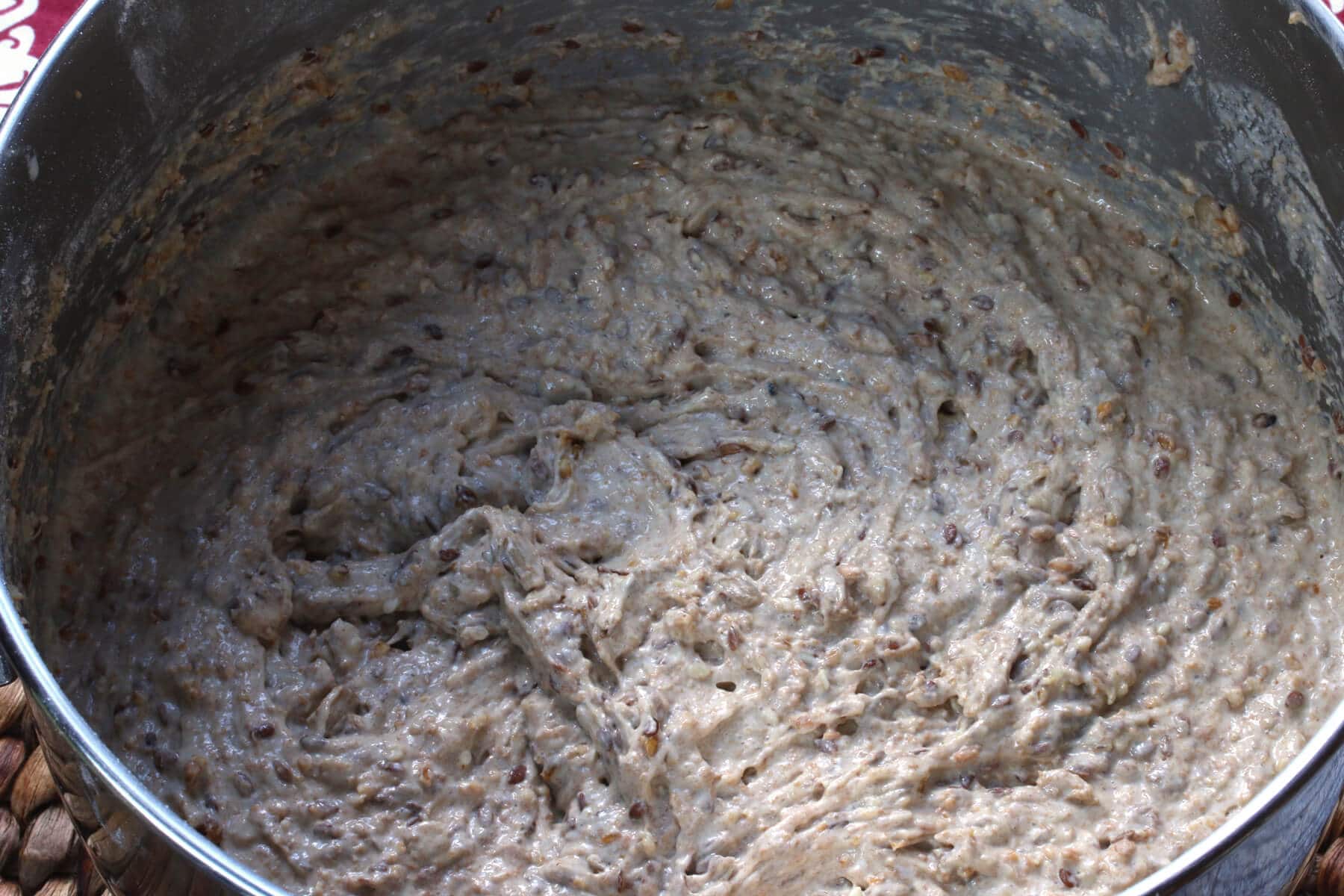
Scoop the mixture into a non-reactive bowl, cover loosely with plastic wrap and let it sit at room temperature for at least 8 hours, preferably longer, up to 24 hours (the longer the better for the whole grain berries to soften and for heightened sourdough properties. If you’re letting it sit for less than 24 hours, presoak the grains overnight in advance and drain thoroughly). Also, the longer it ferments the more liquid will be absorbed so less chances of a moist center after baking.
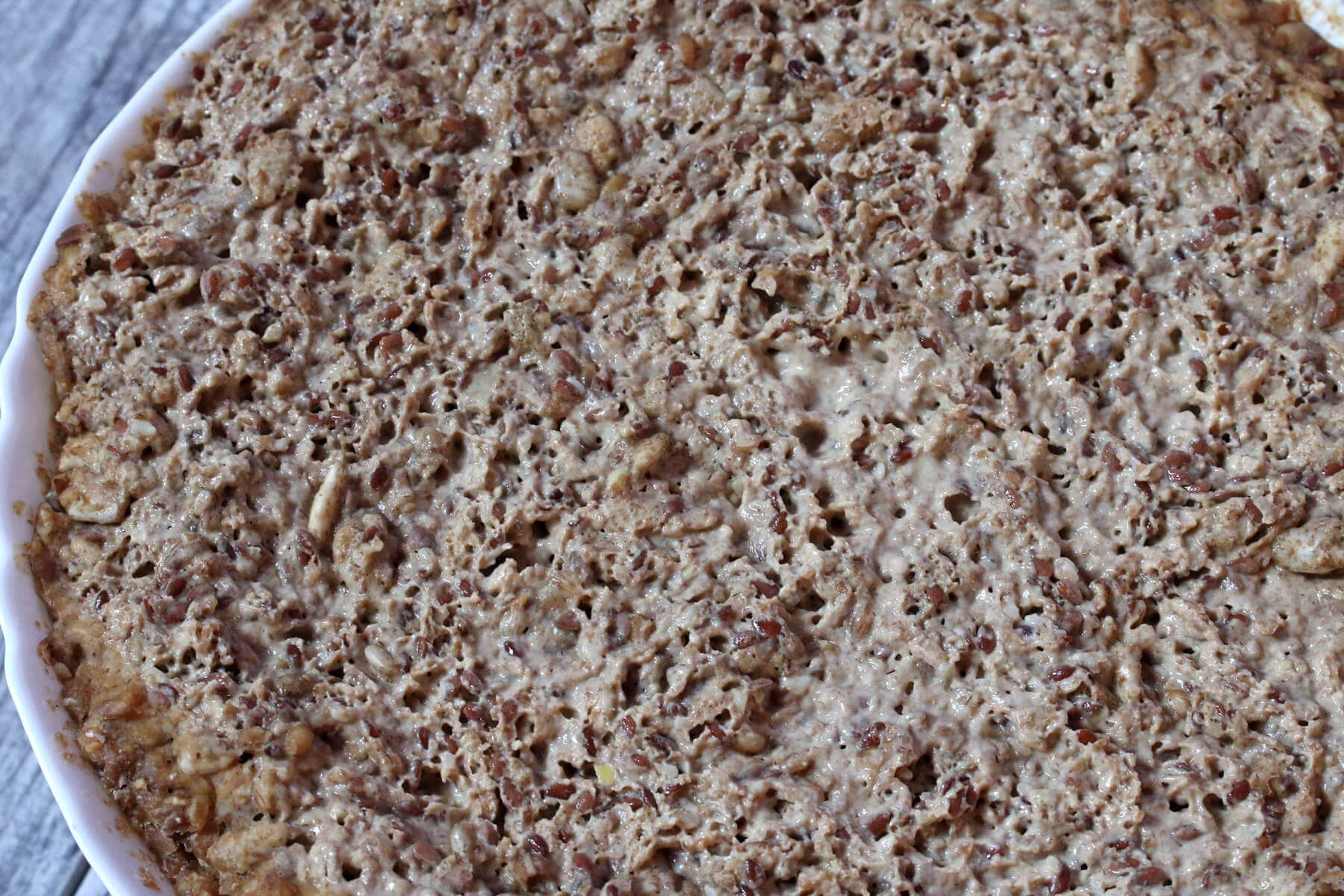
The mixture will be thick and gooey but will not resemble typical bread dough.
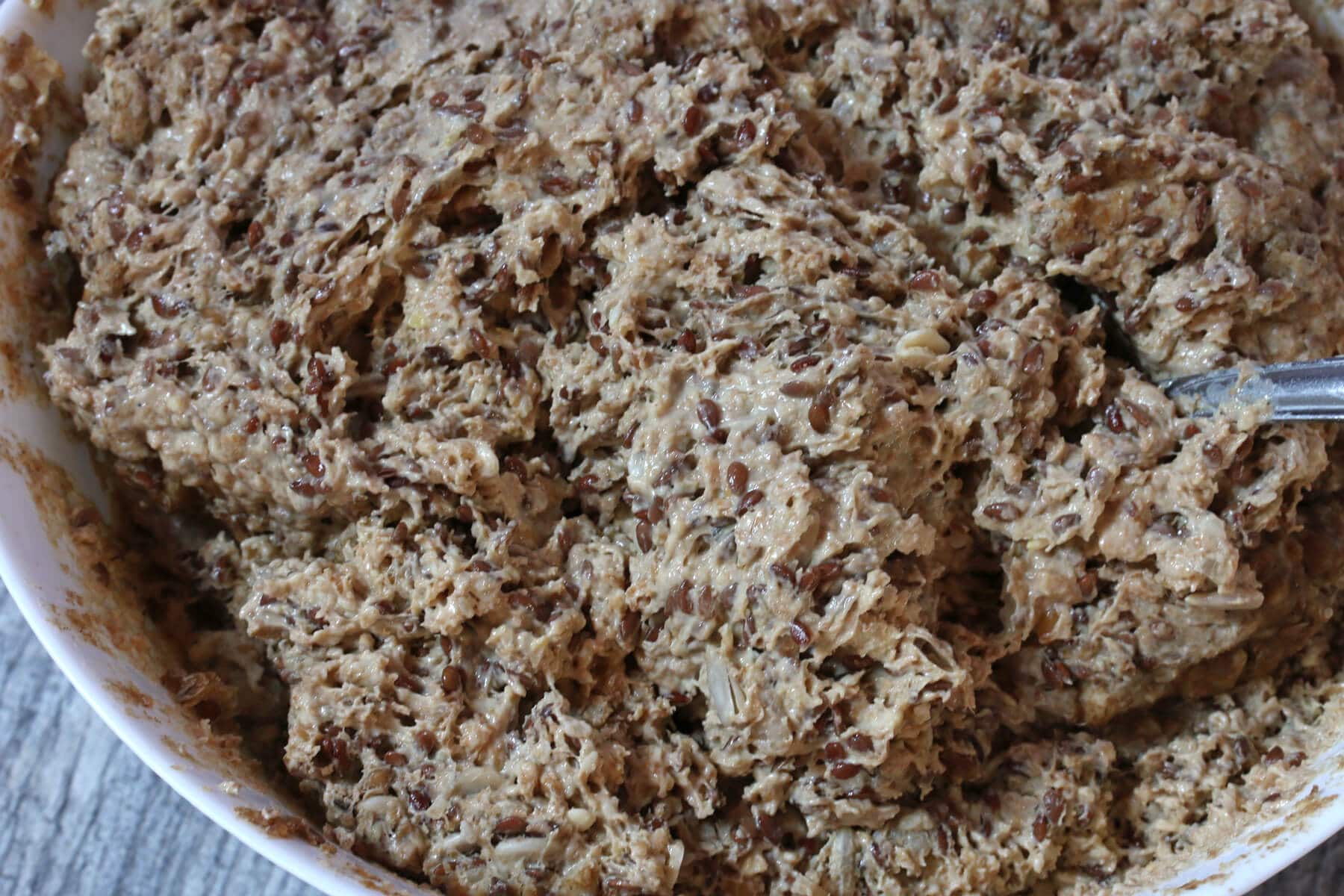
Scoop the mixture into a generously buttered Pullman Loaf Pan and smooth the top so it’s even.
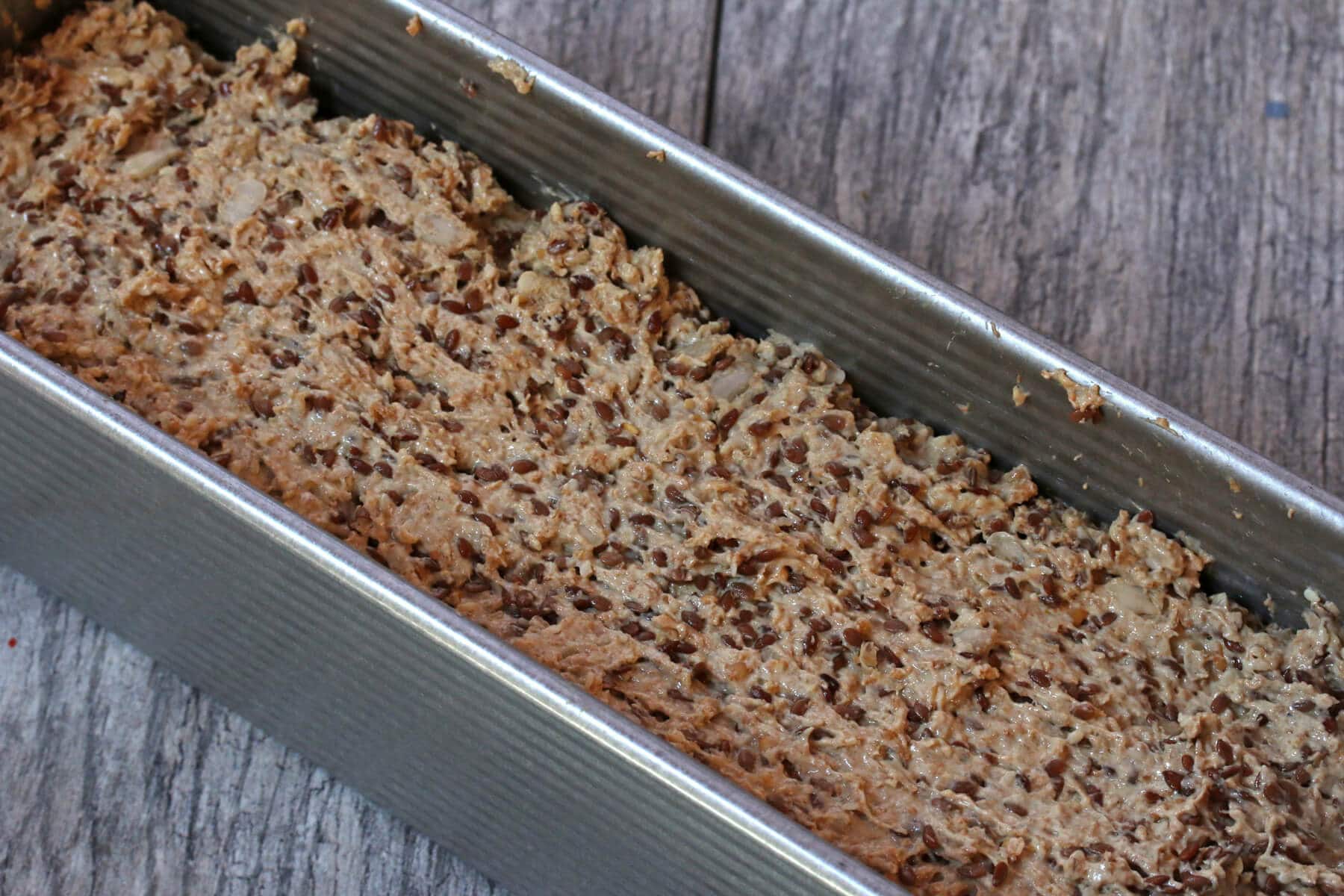
Baking this bread in a Pullman loaf pan yields those nice small, square slices of bread. But it also helps ensure that the center of the bread is fully cooked. Plus, when I’m making other breads that rise a lot, the Pullman has a top on it that slides shut to keep the bread compact (this Einkornbrot doesn’t rise a lot during baking so I don’t bother putting the lid on for it). It’s also the loaf pan that is used to make the famous French pain de mie bread. I like to use it for a lot of my heartier European style breads.
Sprinkle the top with rolled oats.
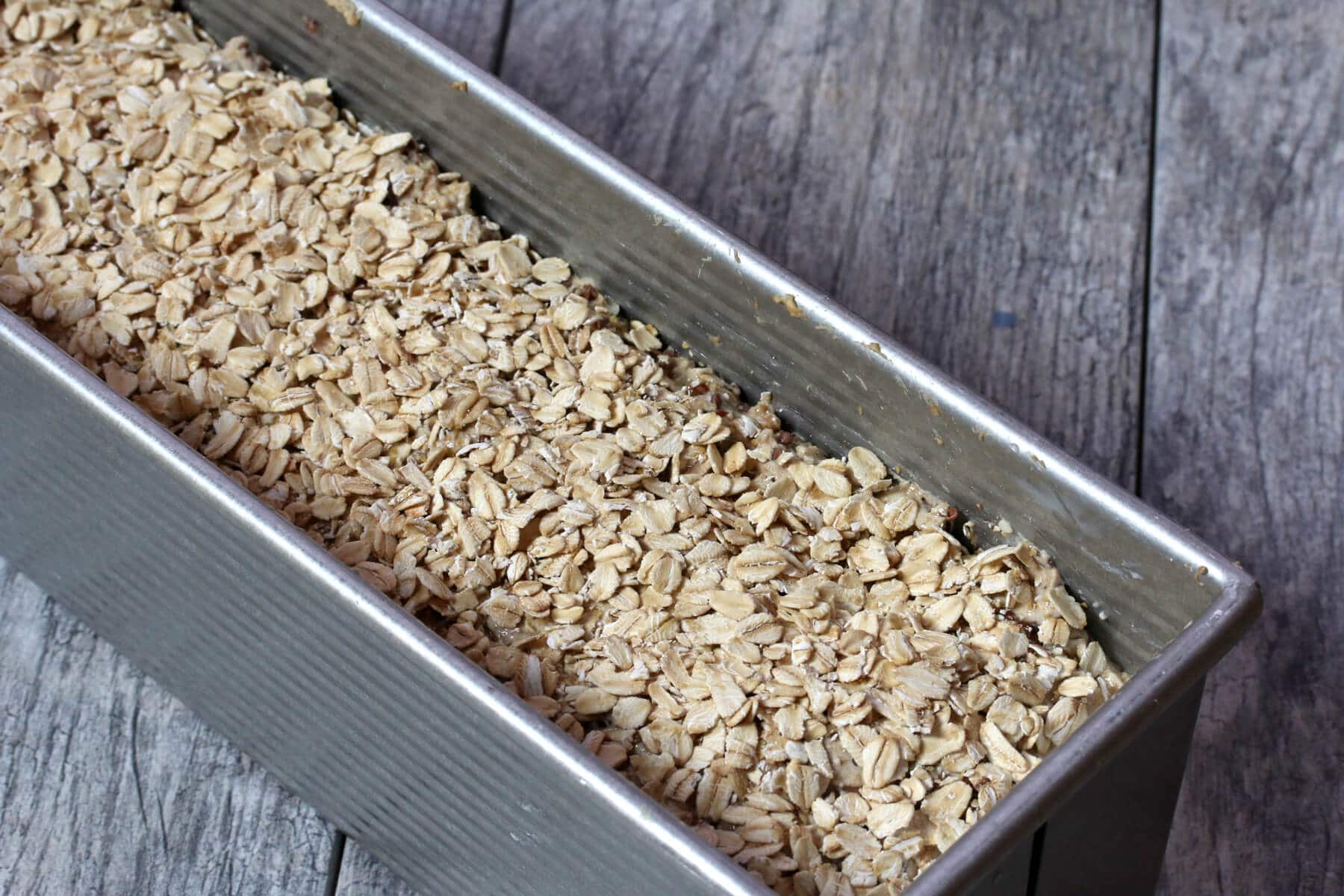
In an oven preheated to 350 degrees F, bake it on the middle rack for 100-120 minutes or until the center is done.
For best and most accurate results, use an instant read thermometer and aim for an internal temperature of 205-210 degrees F.
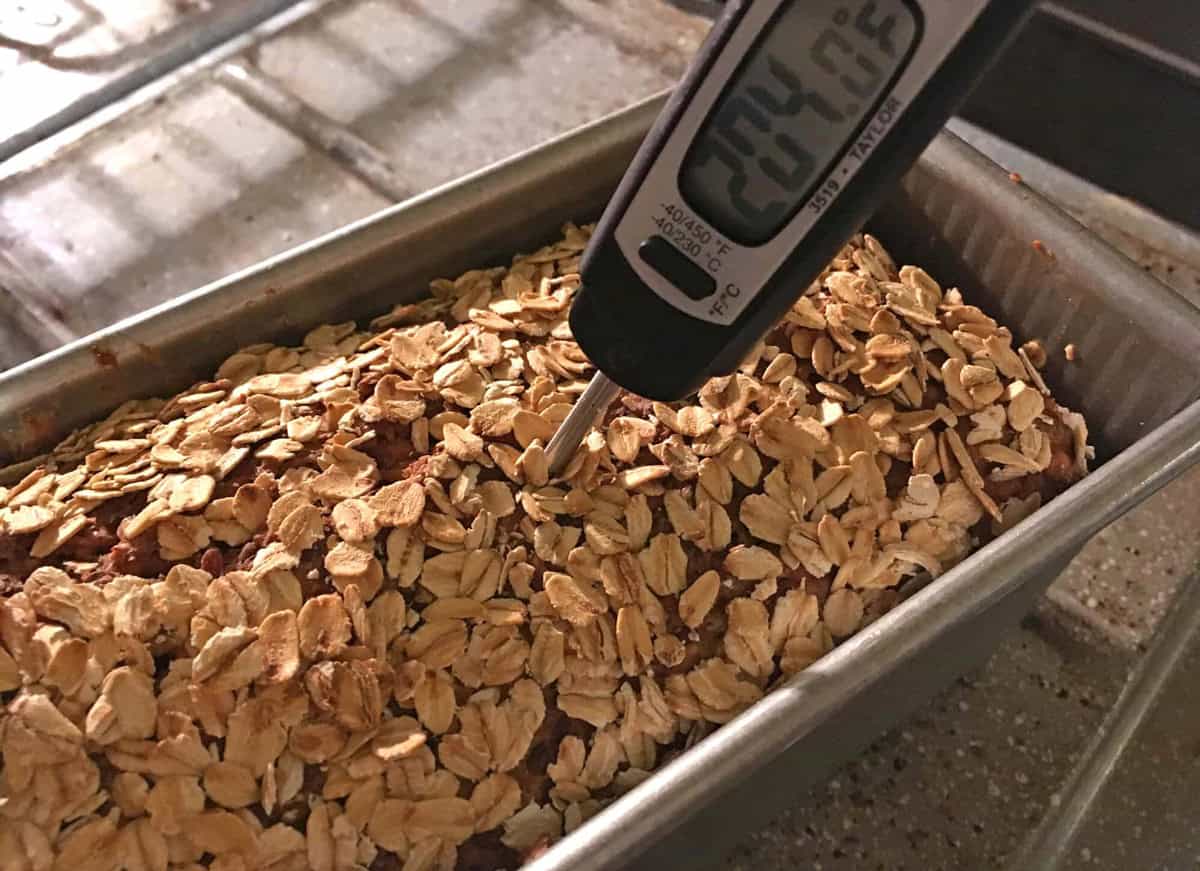
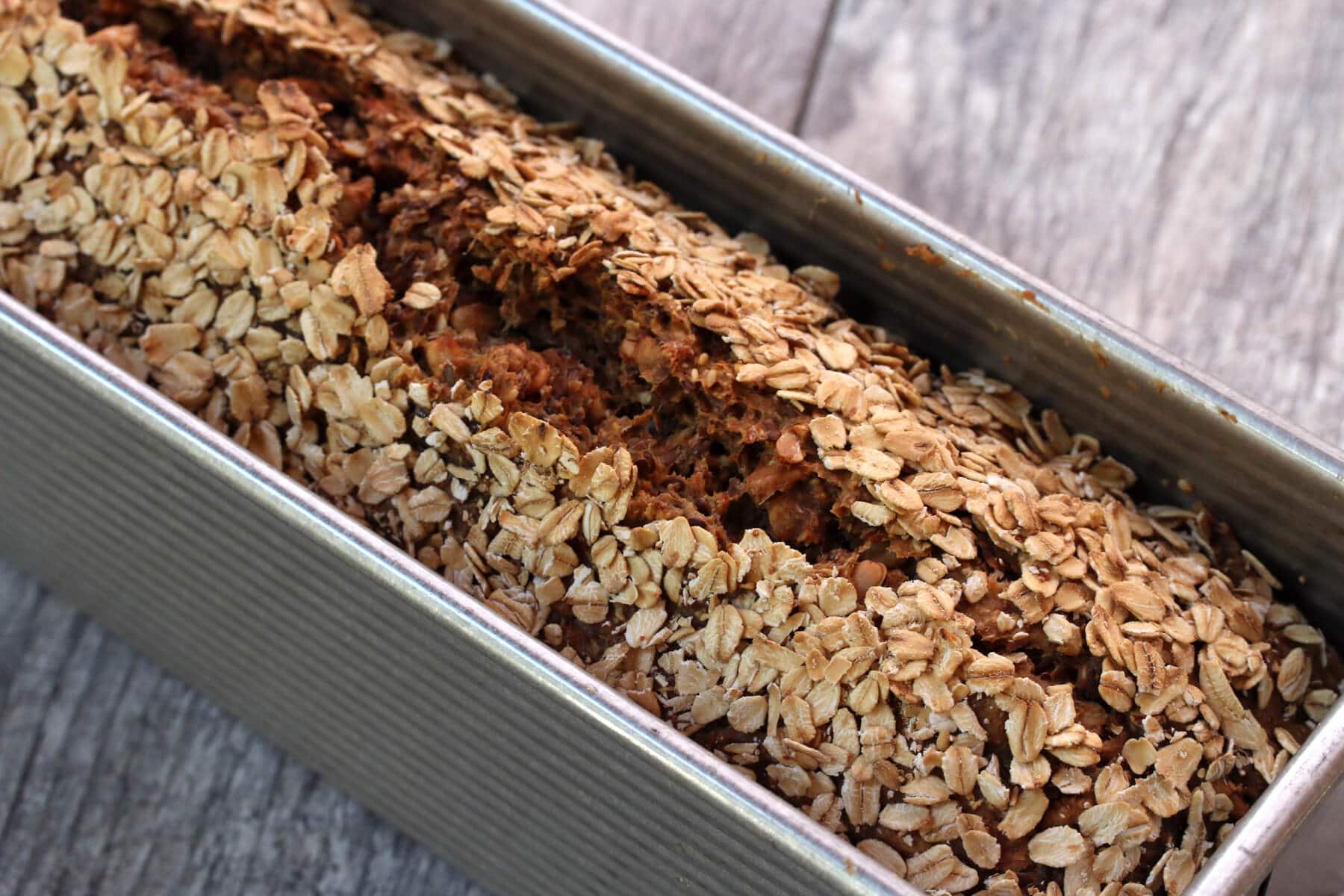
Let is sit in the pan for 5 minutes before removing it, then let it cool completely on a wire rack.
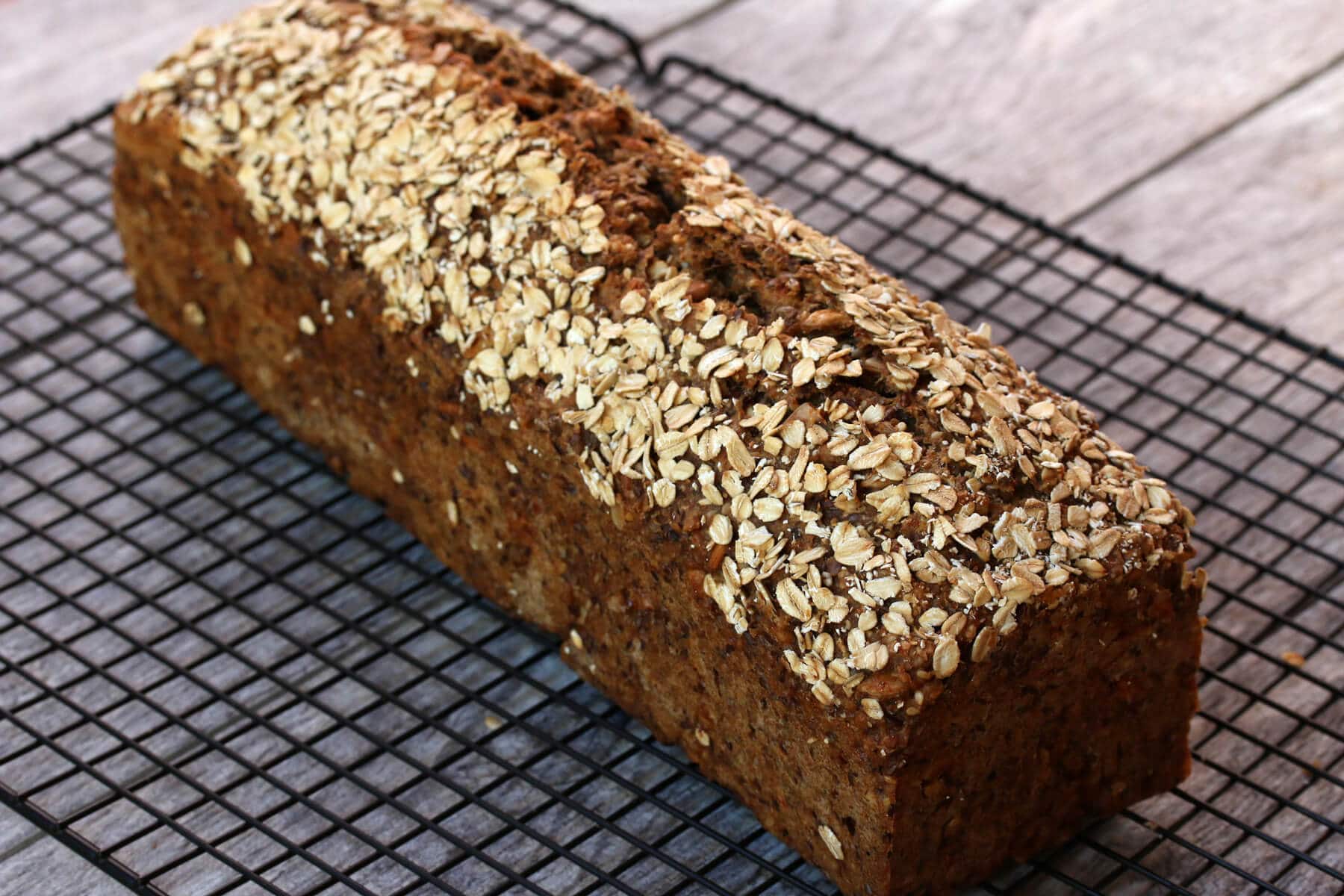
Once cooled you can slice the entire loaf in advance or slice as needed.
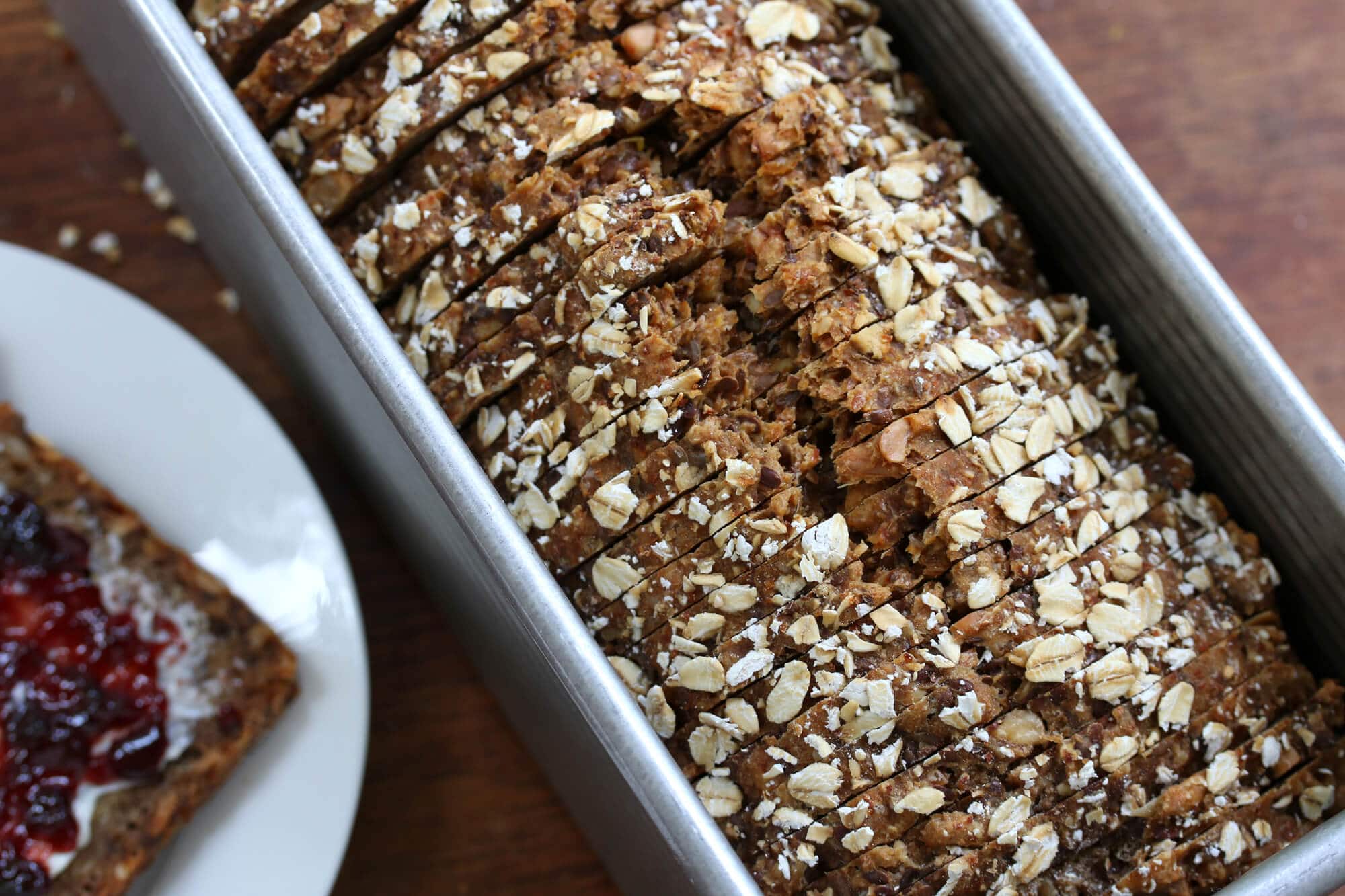
We have a decades-old Hobart commercial slicer that we picked up on Craigslist years ago. I used to be the manager of a delicatessen in England and Hobart is the gold standard in food slicers. In fact, the very same model that we have is on display at the Smithsonian!
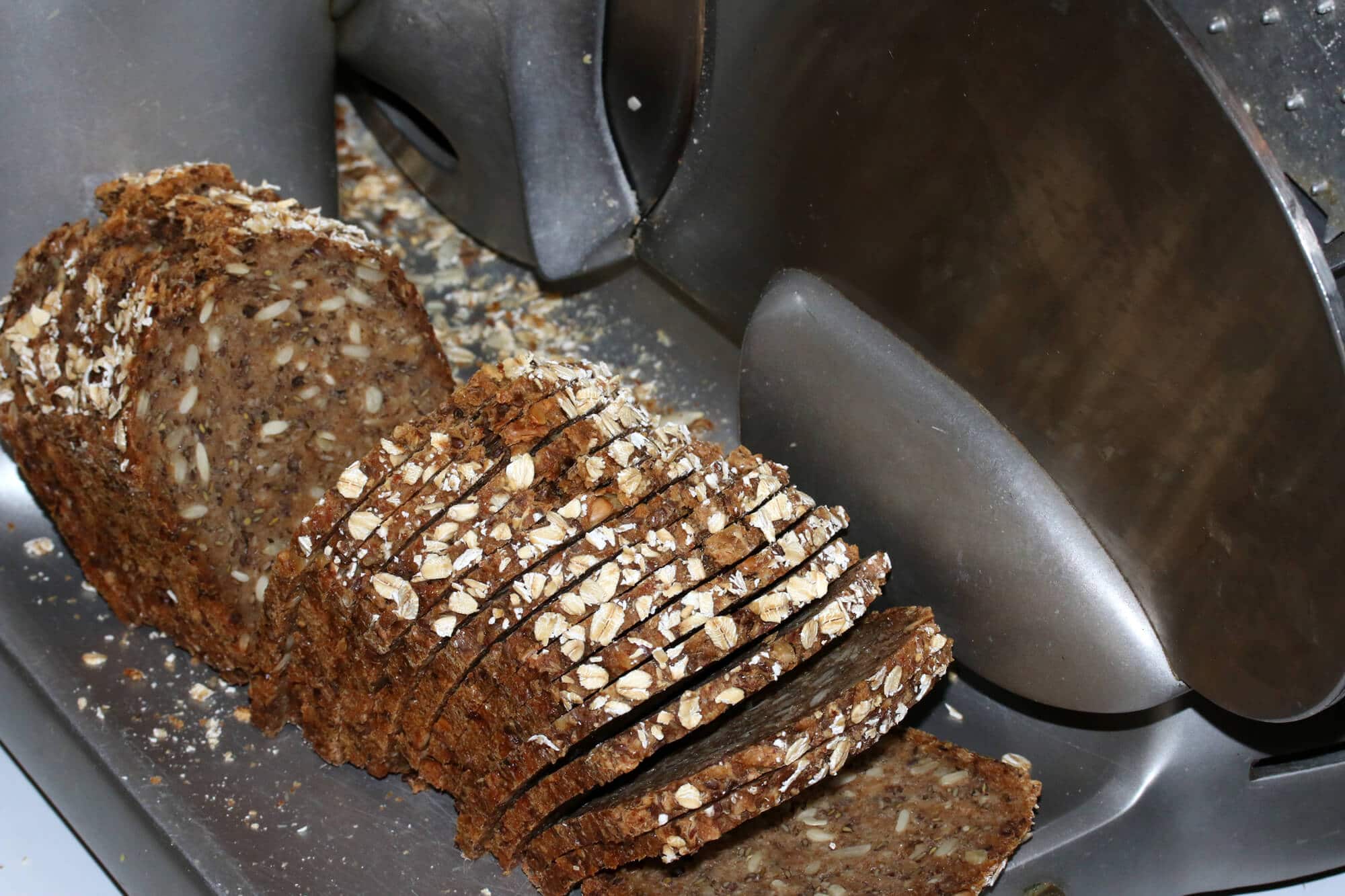
I realize we got lucky and most of you aren’t going to find a good-priced Hobart on Craigslist, but there are other good slicers on the market that are vastly cheaper and do the job. Chef’s Choice Slicers are consistently ranked at the top. I haven’t personally tried one, but they get excellent reviews. Having a good slicer to get clean, thin slices of bread that look like something you bought at a professional bakery is really nice. Plus, whenever I find chunks of cooked ham, turkey or cheese on sale I get those and slice them myself – it’s much cheaper than buying them at the deli.
At the very least you’ll need an excellent bread knife and for that my favorite knife, hands down, is the Cutco 9 3/4″ Slicer. It glides smoothly through bread and meat like no other.
Enjoy!
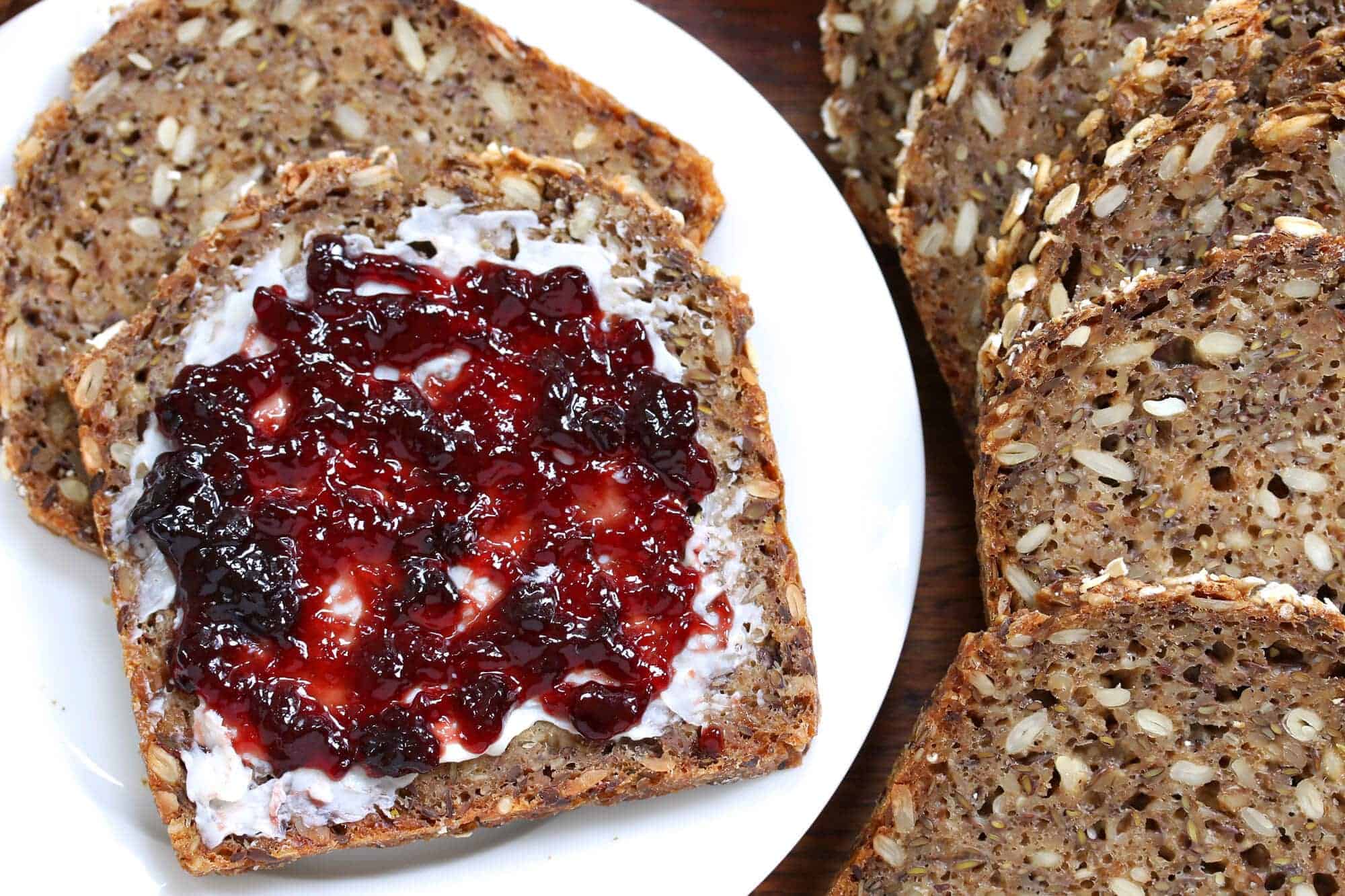
For more delicious bread from around the world be sure to try my:
- Lavash
- Injera
- Dosa
- Sourdough Naan
- Danish Rye Bread
- Crumpets
- Olive Rosemary Focaccia
- Skillet Cornbread
Save This Recipe

German Bread (Authentic Vollkornbrot)
Ingredients
- 4 1/2 cups einkorn flour (you can also use whole wheat, spelt, rye or combination)
- 1/2 cup whole einkorn berries , or wheat, spelt or rye berries (***See NOTE about soaking)
- 1 3/4 cups cracked einkorn berries , or wheat, spelt, rye (**See NOTE about cracking the grains **See NOTE about soaking)
- 1 cup whole flax seeds
- 1 1/2 cups sunflower seeds
- 1/4 cup sesame seeds
- 3 teaspoons salt
- 2 teaspoons dry active yeast ** see Note for sourdough substitution
- 2 tablespoons sugar , optional but recommended
- 2 cups lukewarm water
- 2 cups buttermilk , at room temperature
- 1 cup mild beer (optional, for a maltier flavor) , at room temperature (can substitute water or buttermilk instead)
- Rolled oats for sprinkling
Instructions
- Dissolve the yeast and sugar in the lukewarm water and let it sit for 5-10 minutes until frothy.
- Combine all of the dry ingredients in the bowl of a stand mixer. (You can do this by hand if you prefer.) Then add the yeast mixture along with the buttermilk and beer. Attach the dough hook and knead on the bread setting (#2) for 10 minutes. Scoop the batter into a large non-reactive bowl, cover loosely with plastic wrap, and let it sit at room temperature for at least 8 hours, preferably longer, up to 24 hours (the longer the better for the whole grain berries to soften and for heightened sourdough properties. Also the longer it ferments the more liquid will be absorbed so less chances of a moist center after baking.)
- Preheat the oven to 350 degrees F.
- Scoop the batter (it will be thick and gooey but not like regular bread dough) into a generously buttered 13x4x4 Pullman loaf pan and smooth the top to even it out. Sprinkle with oats. (Note: Baking this bread in a Pullman loaf pan yields those nice small, square slices of bread. But it also helps ensure that the center of the bread is fully cooked.) I always bake this without the lid on.
- Bake on the middle rack for 100-120 minutes or until the center is done. For best and most accurate results use an instant read thermometer and aim for 210 degrees F. Let the bread sit in the pan for 5 minutes before removing it, then let it cool completely on a wire rack before slicing it. To get clean, professional slices I highly recommend using a bread slicer.
Notes
- How to “crack” the whole berries: I use my grain mill to crack them by putting it on the coarsest setting. Another option is if you have a Vitamix and use the dry container – pulse the whole berries a few times until you get coarse pieces of einkorn. A powerful food processor will likewise do the job. Alternatively you can also place the whole berries in a ziplock bag and use a heavy object to pound them to break them up.
- Soaking the Grains: I personally don’t pre-soak the whole or cracked grain berries and just let my batter ferment for a full 24 hours which softens the berries, and I’ve always had great results. However, depending on the age of the grains you’re using (even if you just bought them they may have sat in the store or warehouse for a long time) they may require a pre-soaking in order to be adequately soft. If you wish you can pre-soak the grains overnight (pour hot water over them and let them sit) and then thoroughly draining.
- **Sourdough Substitution: To make this a sourdough Vollkornbrot omit the yeast, add 200 grams of active sourdough starter, and reduce the flour by 100 grams and the water by 100 grams. Give the batter a full 24 hour ferment.
Nutrition
Originally published on The Daring Gourmet December 11, 2019



















Hi, would it be OK to substitute pepitas for the sunflower seeds? Looking forward to trying this recipe! Thank you.
Absolutely, Jill! Happy baking! :)
I wrote a month or so ago re a funky off odor that came from two batches while fermenting for 24 hours. The resulting bread was not bad but not as terrific as the other two loaves I’ve made. I didn’t see a reply. My question: would it make sense to ferment for part of the time in the fridge? Then allow to warm to room temp and continue fermenting for the remainder of the time at room temp?
Hi Tamara, I apologize, I didn’t see another comment. The cold temperature of the fridge will prevent fermentation. If your goal is to enable the grains to fully soften and absorb the excess liquid while preventing the stronger flavor that comes from a longer ferment, then refrigerating it for part of the time will probably do the trick. Also, if you prefer a milder tasting bread I would recommend not using the beer.
Thank you so much!! Am making my fifth loaf and refrigerated over night then let it ferment for an extra 4 hours so 28 hours altogether. Will let you know how it turns out.
I am a wheat farmer in the US and came across this recipe while looking for a healthier homemade bread. I appreciate you pointing out differences in modern and ancient wheat without slamming farmers. 🙂 I would mention that even modern wheat comes in many varieties that all look different, some much shorter like Einkorn, so the visual comparison isn’t significant. I look forward to trying this recipe! Thanks!
Hi Alea, thank you for that and likewise for not slamming me for pointing out some of those differences :) I’ve updated the part about size differences to take into account the exceptions – thank you. I’m really happy that you found my site and I hope you enjoy this bread. I’d love to hear your thoughts when you’ve had the chance to make it!
My wife and I recently returned from vacationing in Budapest, Vienna, and Prague. I did not eat any bread that I preferred to this. I love this recipe and make it regularly. My Mother, born and raised in Norway loves it too!
Oh that’s wonderful, thank you so much for the positive feedback, Erik, I appreciate it!
This is great. Tastes just like in Germany. It’s chewy and grainy and wholesome – the texture is terrific. I have made this several times now, and it comes out great. (I experimented with the recipe once, adding grated carrots and hazelnuts, and it came out super wet – that’s on me!) Whole Foods stores einkorn flour (at, you know, WF prices), and it can be hard to get Einkorn berries but there are online companies that sell them at a reasonable price. After the first time I made this recipe I bought in bulk and bake the bread every couple of weeks. It’s a keeper.
That’s fantastic, Alex, I’m so happy that this has become a regular and I really appreciate the positive feedback, thank you! <3
Hi Alex, I tried it once and like to explore it more, now looking into bulk purchasing. If you don’t mind me asking, which online bulk supply would you recommend ?
I have made various versions of this bread for a year or so, and am always searching for the perfect one – not too hard a crust to slice it, not gummy in the center, holds together in a slice as you eat and so on. I was excited to try this, as I usually presoak the grains and drain them – this was an easier way, as you said there was no need to soak the grains if they were fresh. However, after 24 hours covered it was not soft or batter like but a very stiff dough that was hard to scoop, had to be packed into the pullman pan, and while it is not cool enough to try to slice it, it seems very hard – I have it in a plastic bag to try to redestribute moisture to the crust a bit. It was 205 degrees internally when I took it out. My grains were fresh from the whole food store, and harvested this past fall, kept in the fridge in the store and here, so in general I feel the recipe needs a tweak or suggestion as to how to know if you need to soak ahead of time, or how much extra liquid might be added if you see it getting stiff – sadly I went to bed and it was stiff by the morning – a bit too late to add liquid?
Hi Lyn, it is supposed to be a very stiff batter, not remotely “pourable”. Having to scoop it in to the Pullman pan sounds just as it should be. Yes, the crust will be hard initially, that’s likewise normal, and it will soften in time. How is your bread now that some time has passed?
I’m making my fourth batch of this bread, have invested in a pullman pan and follow the recipe as stated. The first and third batch were just like the fabulous bread I find in Germany. My German Mum as well as others in my family love it. But twice when I’ve made it the dough has over fermented and smelled bad. The resulting bread still tastes alright and is definitely edible but not as fantastic as the other two times when this hasn’t happened. Tonight I baked the bread after 8 hours of fermentation instead of the usual 20-24 hours as I noticed that the fermentation process had stopped, the dough had deflated a bit and it was beginning to smell not so good. Any thoughts on what could be causing this to happen? I leave the dough to ferment in the large steel bowl of the mixer in a relatively cool house 65-67F.
I’ve just tried this for the first time and really look forward to it. When we were in Germany a few years ago, we enjoyed this bread immensely and I’m glad to find a recipe.
My question is —
I do not have a Pullman loaf pan and wanted to have two loaves anyway. How long should I cook this in a standard loaf pan?
Hi, the main difference in the Pullman loaf its length so baking time shouldn’t be significantly different using a shorter standard loaf pan. It may mean baking it a little longer due to slightly larger circumference of the bread, but if you have an instant read thermometer, which I always recommend, it will take the guesswork out of it.
I love the flavor of the bread and the heaviness of the bread. However, I am having a hard time baking the bread. I have a good stove and set the electric oven for 350 degrees. I am cooking the bread for three hours and the highest temp I have registered with an instant read thermometer is 200 degrees. After three hours, I always take the bread out and put it on a cooling rack. The center of the bread is not cooked to perfection. I am using the pullman pan. Does anyone else have the problem of having to cook the bread so long. And we are using einkorn wheat and following the recipe exactly except I use three cups of buttermilk instead of a cup of beer. Marilyn